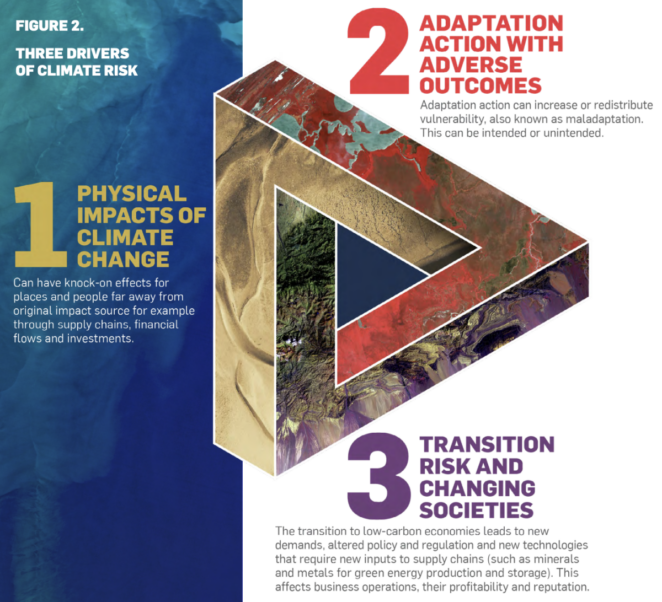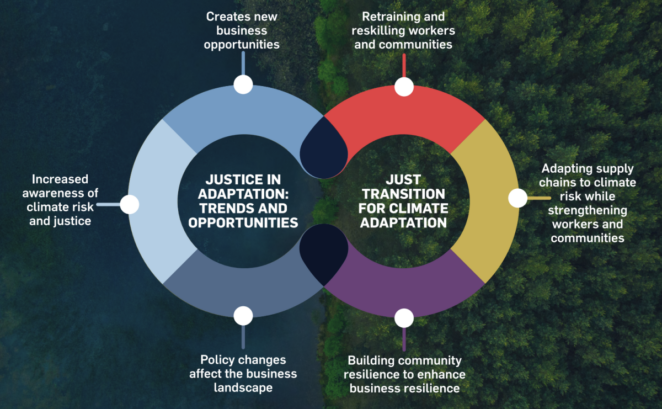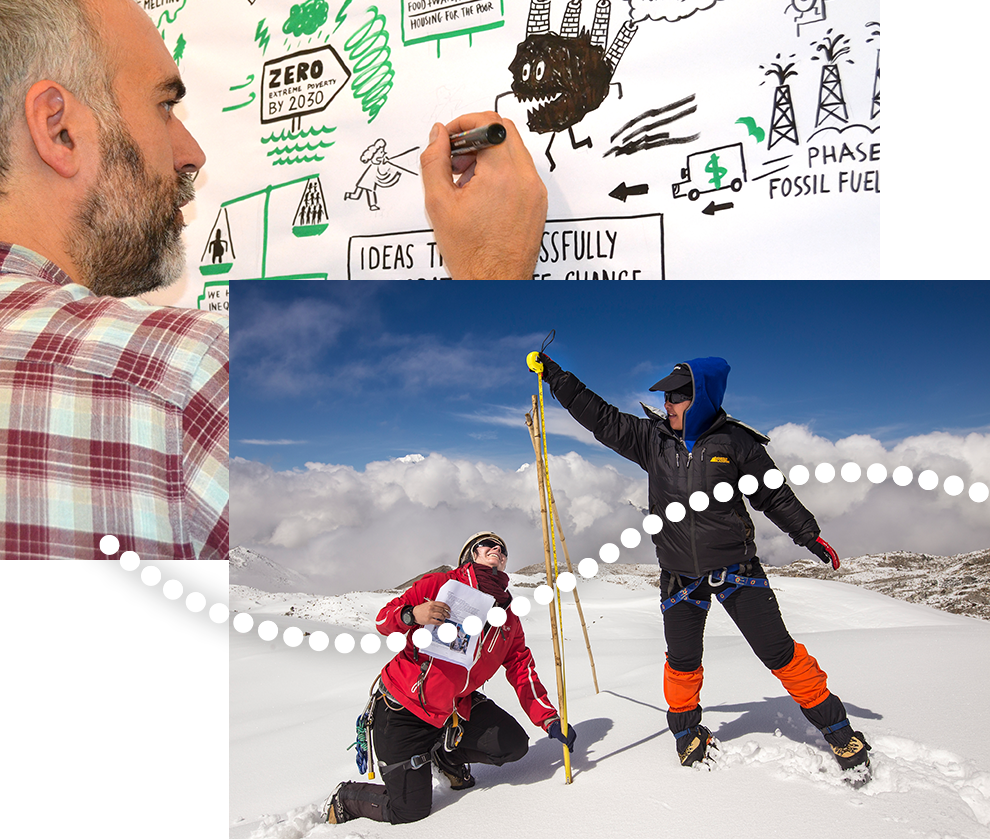Just transition for climate adaptation: A business brief

Introduction
A just transition works to ensure that the shift to net-zero emissions and climate resilience is orderly, inclusive and just, creates decent work opportunities and leaves no one behind. This brief focuses on just transition for climate adaptation, which refers to actions taken to adjust to the risks and impacts of climate change. More specifically, it emphasizes adaptation to climate risk for businesses, workers, producers, communities and supply chains.
The objective of this brief is to highlight the important role of adaptation action for large multinational corporations that aim to achieve a just transition. Its focus is on how businesses can adapt to minimize climate change risks and impacts in a just and equitable manner. The operations of large companies connect producers to far-away consumers through global supply chains that are exposed to climate risks and impacts in various ways. Climate change and misguided adaptation action can cause resource scarcity (such as water scarcity affecting human health, hunger, crop yields and mining and processing facilities). They can jeopardize jobs and livelihoods, exacerbate conflict and cause supply chain disruptions. Consequently, just transition strategies need to address both the physical risks of climate change as well as the companies’ own adaptation responses. A just transition strategy for businesses that integrates climate adaptation can help reduce unequal burdens and leave no one behind.
This article is an abridged version of the original text, which can be downloaded from the right-hand column. Please access the original text for more detail, research purposes, full references, or to quote text.
Business Exposure to Climate Risks
Businesses are increasingly seeing climate change as a significant strategic and operational risk, requiring adaptation action. Questions around climate and sustainability have shifted from being siloed in sustainability departments and targeted interventions to something that should be considered as part of the core business strategy, owned and driven across the organization. For example:
- There is an increased awareness among businesses of exposure to risks linked to the physical impacts of climate change.
- In addition to the exposure to physical climate risks and impacts, multinational corporations need to consider the consequences of their adaptation actions.
- Lastly, a transition to climate-resilient operations can offer both new business opportunities and can improve awareness of social equity and human rights in relation to, for example, raw material extraction and new technologies.

A Socially Responsible Approach to Climate Risk and Adaptation for Business
The integration of social aspects into how businesses adapt to climate risk is increasingly being considered in terms of workers and supply chains, creating possible mutual gains. For example, social protection — aiming to prevent poverty and maintain decent incomes and living standards — and a responsible reorganization of the workforce through social dialogue can create robust labour relations which ensures training and development opportunities. Beyond direct operations, many multinational corporations see an urgent need for improving and diversifying their supply chains using a just transition approach, ensuring that workers and affected communities are provided with support.
Currently, however, there is no systematic approach to integrating social and environmental aspects in how businesses are adapting to climate risk. There is still a siloed approach and a ‘cultural gap’ in businesses’ understanding of the interactions between environmental and social sustainability. An integrated social and environmental climate risk adaptation and management approach that includes affected communities will not only increase social protection of these communities but also avoid or alleviate local resistance to new projects and the sourcing of new materials needed for the transition to net-zero.

Refer to pages 8-9 to discover more about a socially responsible approach to climate risk and adaptation.
Integrating a Just Transition for Adaptation in Business Strategy
The socio-economic effects of a changing climate will be large and difficult to predict for most businesses. There are several challenges raised by participants of the Think Lab on Just Transition:
- Long-term horizons
- Trade-off between transparency and flexibility
- Low profit margins
- Conflicting goals
- Lack of measurable targets and clarity on roles
- Lack of sustainable investment opportunities
Despite these challenges, opportunities to make climate adaptation action a stronger part of a sustainable business strategy exist:
- The most common approach currently being undertaken is climate scenario analysis, which helps businesses better account and plan for climate risks, often bringing new insights and perspectives.
- Joint learning and information-sharing offer another opportunity to integrate adaptation action better in businesses’ decision-making.
- Partnerships in various forms (global, local, regional and sectoral) with governments, international organizations, civil society and academia already help businesses to increase awareness and change practices on a wide variety of issues.
Explore the opportunities and challenges in more detail on pages 10-11 of the brief.
Conclusion and Recommendations
Many businesses find themselves in new territory when addressing just transition and climate adaptation. In a global and interconnected world, adapting to climate risks and impacts in a way that is just will require collaborative approaches that cross borders, where actors engage with one another to identify shared risks and potential opportunities. Companies need to incorporate climate risks and impacts into the core parts of their business strategy, focusing on a just transition that aligns with a decent work agenda of social dialogue, social protection, rights at work and full and productive employment, which is the foundation for any work on just transition.
Recommendations for businesses to achieve a just transition for climate adaptation:
- Integrate social and environmental objectives into the business strategy through a social dialogue
- Build coalitions, including with competitors
- Improve data collection and sharing
- Strengthen supply-chain resilience
- Financing a just transition and climate adaptation
- Partner with local and regional governments to devise adaptation strategies that advance a just transition
- Advocate for clear division of responsibilities for a just transition, also to support climate adaptation
Refer to page 12 of the brief to learn about the recommendations in more depth.
- Adaptation Without Borders: A brief to participants in COP27
- A Just Transition for Climate Change Adaptation: Towards Just Resilience and Security in a Globalising World
- Adaptation: Business opportunities and responsibilities
- Issues Paper: Challenges and Opportunities for a Just Transition
- Engaging the Private Sector in National Adaptation Planning Processes

Comments
There is no contentYou must be logged in to reply.